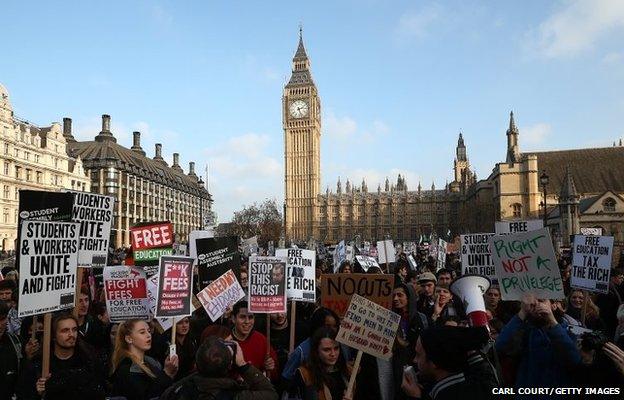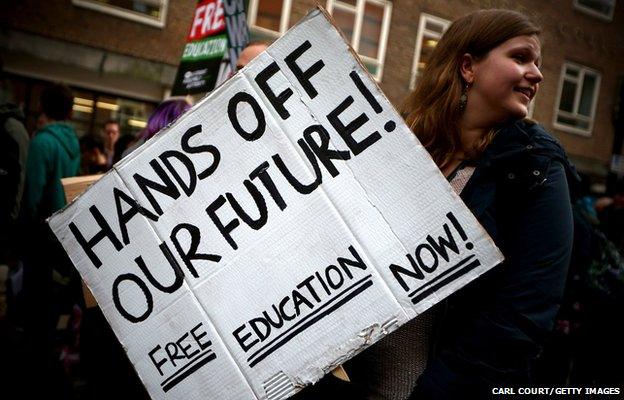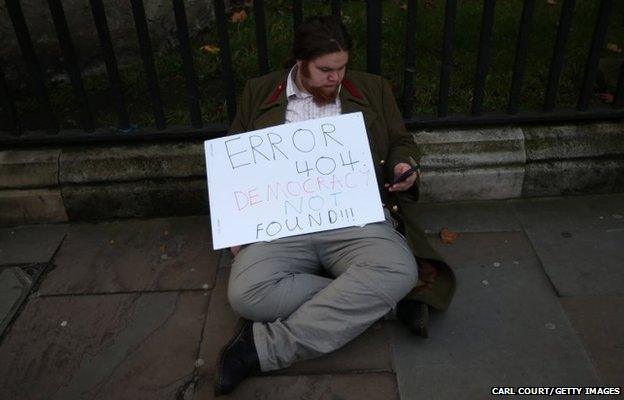Picture power: Pausing the moment
- Published
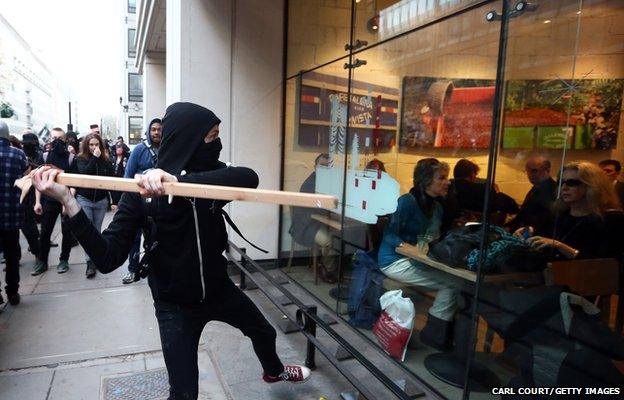
I want to take a look at this picture taken by Carl Court in London last week during a march by thousands of students protesting against education cuts, tuition fees and student debt.
For me - although it is something we have seen in previous demonstrations (frame 4 in this gallery for example) - this picture sums up the power of the still image, as it produces more questions than answers.
Those questions should spark an interest in the subject and entice us to want to know more. What it doesn't do is close down the debate.
Who is in the picture and why they are there will, of course, be addressed by the caption; in this case it is a moment of violence during the student protest.
But what was happening moments either side of when the frame was shot? What is going on just out of frame? Is this man alone, or with a group? And so on…
Here we have a young man about to strike at the window of a Starbucks coffee shop with a wooden stick, and inside two women are seemingly unaware of what is about to happen.
Initially that is it, and our reaction, or mine at least, is to wonder if the glass will break and when the women are going to look up and focus on what is happening outside.
Of course, we know that in an encounter between a small wooden pole and thick industrial glass, the latter will always win, so the people are safe. Yet they are in for a shock, and something that may well be very upsetting to them.
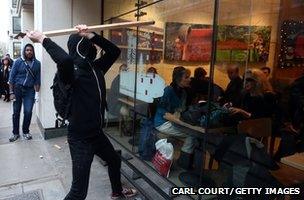
A similar frame taken by Carl Court
You can see in the first few seconds of this video on YouTube, external how quickly the moment passes. One blow and the attacker is gone, melting back into the crowd. The force used is actually fairly low, so I would say the intention was to strike the glass rather than break it. It also shows why those inside have yet to react.
But what else should we do when looking at a picture? We can ask how it was taken. Remember that in pictures, one of the key players is always missing - the photographer.
Carl Court took this picture while working for Getty Images and he told me: "I usually do a fair bit of planning ahead on covering protests like these student demonstrations in London - checking routes, trying to ascertain if there are any troublemaking elements within the protest that might splinter off and establishing, in advance, how many people will be involved in the protest.
"Often you have to gauge the mood on the ground and react to things that happen there and then. When trouble does occur it's usually after a more hardcore group has left the main protest and moves off. As a photographer I keep an eye out for this as it tends to be a sign that trouble will take place.
"It's often, but not always, the case that these groups focus anger towards government buildings or corporations like Starbucks or McDonald's, so I look out if the group passes one.
"In this instance, the group had started throwing things around in the street and the person with the pole seemed to appear from nowhere as I passed Starbucks with the group.
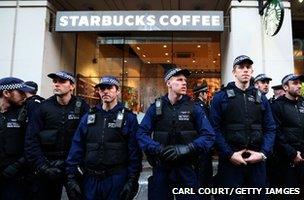
"I saw him turn towards the building and positioned myself at the best angle I could to show the pole being swung, as well as the customers in the coffee shop. The police arrived immediately after and it was all over in seconds."
The context in which a picture is used also plays a role in how we read it. Here we have a news picture that was taken to be published alongside editorial copy, a news report that will complement the image with facts and figures relating to the event.
Indeed, reports say demonstrators outside the coffee shop were chanting criticism of the company's tax affairs. The BBC report also notes that the march was supported by groups including the Student Assembly Against Austerity and the Young Greens. But it was not endorsed by the National Union of Students (NUS), whose central London headquarters was daubed with graffiti, including the word "scabs".
Whether actions like the one shown in this picture help the student cause is up for debate. I imagine the vast majority of those on the march would not want to be associated with anything other than peaceful protest.
Each of us will see something slightly different in a photograph and will interpret it in our own way.
This then brings into play the other key figure in a picture - you, the viewer. Your views and beliefs will affect the way you see a picture. Is this a justified moment of protest against a multinational company, just mindless hooliganism, or even a gesture in the heat of the moment?
So whatever the subject matter it does no harm to look at the forces at work behind images you see in the news, or indeed elsewhere. How was it taken? Where would the photographer have had to be and how did they get there? Who is publishing it? What of the people in the picture? How are they influencing an image? And lastly, are you giving the picture a chance or have you made up your mind about it already?
A lot of work goes into that 1/250th of a second that you see on the page, but that is really just the start.
I must add that the event was a largely peaceful demonstration that ended with a rally in Parliament Square, and during the day, police made 11 arrests.
Here are a few more of Carl Court's pictures from the day.
